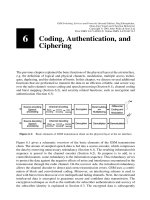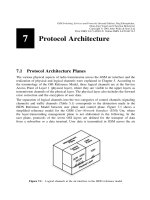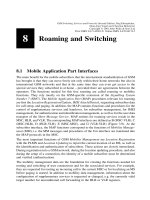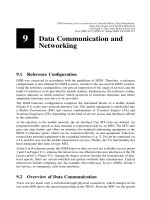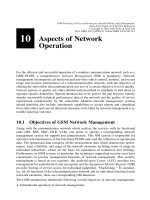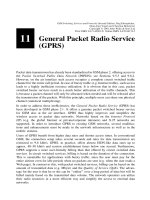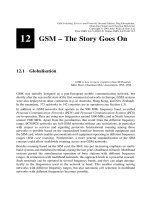Tài liệu GSM switching services and protocols P2 doc
Bạn đang xem bản rút gọn của tài liệu. Xem và tải ngay bản đầy đủ của tài liệu tại đây (444.49 KB, 20 trang )
The Mobile Radio Channel
and the Cellular Principle
Many measures, functions and protocols in digital mobile radio networks are based on the
properties of the radio channel and its speci®c qualities in contrast to information trans-
mission through guided media. For the understanding of digital mobile radio networks it is
therefore absolutely necessary to know a few related basic principles. For this reason, the
most important fundamentals of the radio channel and of cellular and transmission tech-
nology will be presented and brie¯y explained in the following. For a more detailed
treatment, see the extensive literature [4,42,50,64].
2.1 Characteristics of the Mobile Radio Channel
The electromagnetic wave of the radio signal propagates under ideal conditions in free
space in a radial-symmetric pattern, i.e. the received power P
Ef
, decreases with the square
of the distance L from the transmitter:
P
Ef
,
1
L
2
These idealized conditions do not apply in terrestrial mobile radio. The signal is scattered
and re¯ected, for example, at natural obstacles like mountains, vegetation, or water
surfaces. The direct and re¯ected signal components are then superimposed at the receiver.
This multipath propagation can already be explained quite well with a simple two-path
model (Figure 2.1). With this model, one can show that the received power decreases much
2
Figure 2.1: Simpli®ed two-path model of radio propagation
GSM Switching, Services and Protocols: Second Edition. Jo
È
rg Eberspa
È
cher,
Hans-Jo
È
rg Vo
È
gel and Christian Bettstetter
Copyright q 2001 John Wiley & Sons Ltd
Print ISBN 0-471-49903-X Online ISBN 0-470-84174-5
more than with the square of the distance from the transmitter. We can approximate the
received power by considering the direct path and only one re¯ected path (two-path
propagation) [42]:
P
E
P
0
4
4
p
L=
l
2
2
p
h
1
h
2
l
L
2
P
0
h
1
h
2
L
2
2
and we obtain, under the simpli®ed assumptions of the two-path propagation model, from
Figure 2.1, a propagation loss of 40 dB per decade:
a
E
P
E2
P
E1
L
1
L
2
4
;
a
E
40 log
L
1
L
2
in dB
In reality, the propagation loss depends on the propagation coef®cient g, which is deter-
mined by environmental conditions:
P
E
, L
2
g
; 2 #
g
# 5
In addition, propagation losses are also frequency dependent, i.e. in a simpli®ed way,
propagation attenuation increases disproportionately with the frequency.
However, multipath propagation not only incurs a disproportionately high path propaga-
tion loss. The different signal components reaching the receiver have traveled different
distances by virtue of dispersion, infraction, and multiple re¯ections, hence they show
different phase shifts. On the one hand, there is the advantage of multipath propagation,
that a partial signal can be received even if there is no direct path, i.e. there is no line of
sight between mobile and base station. On the other hand, there is a serious disadvantage:
the superpositions of the individual signal components having different phase shifts with
regard to the direct path can lead, in the worst cases, to cancellations, i.e. the received
signal level shows severe disruptions. This phenomenon is called fading. In contrast to this
fast fading caused by multipath propagation, there is slow fading caused by shadowing.
Along the way traveled by a mobile station, multipath fading can cause signi®cant varia-
tions of the received signal level (Figure 2.2). Periodically occurring signal breaks at a
distance of about half a wavelength are typically 30±40 dB. The smaller the transmission
bandwidth of the mobile radio system, the stronger the signal breaks ± at a bandwidth of
about 200 kHz per channel this effect is still very visible [8].
Furthermore, the fading dips become ¯atter as one of the multipath components becomes
stronger and more pronounced. Such a dominant signal component arises, for example, in
the case of a direct line of sight between mobile and base station, but it can also occur
under other conditions. If such a dominant signal component exists, we talk of a Rice
channel and Ricean fading, respectively. (S. O. Rice was an American scientist and
mathematician.) Otherwise, if all multipath components suffer from approximately
equal propagation conditions, we talk of Rayleigh fading. (J. W. Strutt, 3rd Baron
Rayleigh, was a British physicist, Nobel prize winner.)
During certain time periods or time slots, the transmission can be heavily impacted
because of fading or can be entirely impossible, whereas other time slots may be undis-
turbed. The results of this effect within the user data are alternating phases, which show
either a high or low bit error rate, which is leading to error bursts. The channel thus has
2 The Mobile Radio Channel and the Cellular Principle
10
memory in contrast to the statistically independent bit errors in memoryless symmetric
binary channels.
The signal level observed at a speci®c location is also determined by the phase shift of the
multipath signal components. This phase shift depends on the wavelength of the signal,
and thus the signal level at a ®xed location is also dependent on the transmission
frequency. Therefore the fading phenomena in radio communication are also frequency
speci®c. If the bandwidth of the mobile radio channel is small (narrowband signal), then
the whole frequency band of this channel is subject to the same propagation conditions,
and the mobile radio channel is considered frequency-nonselective. Depending on location
(Figure 2.2) and the spectral range (Figure 2.3), the received signal level of the channel,
however, can vary considerably. On the other hand, if the bandwidth of a channel is large
(broadband signal), the individual frequencies suffer from different degrees of fading
(Figure 2.3) and this is called a frequency-selective channel [15,54]. Signal breaks because
of frequency-selective fading along a signal path are much less frequent for a broadband
signal than for a narrowband signal, because the fading holes only shift within the band and
the received total signal energy remains relatively constant [8].
Besides frequency-selective fading, the different propagation times of the individual multi-
path components also cause time dispersion on their propagation paths. Therefore, signal
distortions can occur due to interference of one symbol with its neighboring symbols
(``intersymbol interference''). These distortions depend ®rst on the spread experienced
by a pulse on the mobile channel, and second on the duration of the symbol or of the
interval between symbols. Typical multipath channel delays have a range from half a
microsecond in urban areas to about 16±20 ms in mountainous terrain, i.e. a transmitted
pulse generates several echoes which reach the receiver with delays of up to 20 ms. In
digital mobile radio systems with typical symbol durations of a few microseconds, this can
lead to smearing of individual pulses over several symbol durations.
In contrast to wireline transmission, the mobile radio channel is a very bad transmission
medium of highly variable quality. This can go so far that the channel cuts out for short
periods (deep fading holes) or that single sections in the data stream are so much interfered
2.1 Characteristics of the Mobile Radio Channel
11
Figure 2.2: Typical signal in a channel with Rayleigh fading
with (bit error rate typically 10
22
or 10
21
), that unprotected transmission without further
protection or correction measures is hardly possible. Therefore, mobile information trans-
port requires additional, often very extensive measures, which compensate for the effects
of multipath propagation. First, an equalizer is necessary, which attempts to eliminate the
signal distortions caused by intersymbol interference. The operational principle of such an
equalizer for mobile radio is based on the estimation of the channel pulse response to
periodically transmitted, well-known bit patterns, known as the training sequences [4,64].
This allows the determination of the time dispersion of the channel and its compensation.
The performance of the equalizer has a signi®cant effect on the quality of the digital
transmission. On the other hand, for ef®cient transmission in digital mobile radio, channel
coding measures are indispensable, such as forward error correction with error-correcting
codes, which allows reduction of the effective bit error rate to a tolerable value (about 10
25
to 10
26
). Further important measures are control of the transmitter power and algorithms
for the compensation of signal interruptions in fading, which may be of such a short
duration that a disconnection of the call would not be appropriate.
2.2 Separation of Directions and Duplex Transmission
The most frequent form of communication is the bidirectional communication which
allows simultaneous transmitting and receiving. A system capable of doing this is called
full-duplex. One can also achieve full-duplex capability, if sending and receiving do not
occur simultaneously but switching between both phases is done so fast that it is not
noticed by the user, i.e. both directions can be used quasi-simultaneously. Modern digital
mobile radio systems are always full-duplex capable.
Essentially, two basic duplex procedures are employed: Frequency Division Duplex
(FDD) using different frequency bands in each direction, and Time Division Duplex
(TDD) which periodically switches the direction of transmission.
2 The Mobile Radio Channel and the Cellular Principle
12
Figure 2.3: Frequency selectivity of a mobile radio channel
2.2.1 Frequency Division Duplex (FDD)
The frequency duplex procedure has been used already in analog mobile radio systems and
is also used in digital systems. For the communication between mobile and base station,
the available frequency band is split into two partial bands, to enable simultaneous sending
and receiving. One partial band is assigned as uplink (from mobile to base station) and the
other partial band is assigned as downlink (from base to mobile station):
² Uplink: transmission band of mobile station receiving band of base station
² Downlink: receiving band of mobile station transmission band of base station
To achieve good separation between both directions, the partial bands must be a suf®cient
frequency distance apart, i.e. the frequency pairs of a connection assigned to uplink and
downlink must have this distance band between them. Usually, the same antenna is used
for sending and receiving. A duplexing unit is then used for the directional separation,
consisting essentially of two narrowband ®lters with steep ¯anks (Figure 2.4). These ®lters,
however, cannot be integrated, so pure frequency duplexing is not appropriate for systems
with small compact equipment [15].
2.2.2 Time Division Duplex (TDD)
Time duplexing is therefore a good alternative, especially in digital systems with time
division multiple access. Transmitter and receiver operate in this case only quasi-simulta-
neously at different points in time; i.e. the directional separation is achieved by switching
in time between transmission and reception, and thus no duplexing unit is required.
Switching occurs frequently enough that the communication appears to be over a quasi-
simultaneous full-duplex connection. However, out of the periodic interval T available for
the transmission of a time slot only a small part can be used, so that a time duplex system
requires more than twice the bit rate of a frequency duplex system.
2.2 Separation of Directions and Duplex Transmission
13
Figure 2.4: Frequency and time duplex (schematic)
2.3 Multiple Access Procedures
The radio channel is a communication medium shared by many subscribers in one cell.
Mobile stations compete with one another for the frequency resource to transmit their
information streams. Without any other measures to control simultaneous access of several
users, collisions can occur (multiple access problem). Since collisions are very undesirable
for a connection-oriented communication like mobile telephony, the individual subscri-
bers/mobile stations must be assigned dedicated channels on demand. In order to divide the
available physical resources of a mobile system, i.e. the frequency bands, into voice
channels, special multiple access procedures are used which are presented in the following
(Figure 2.5).
2.3.1 Frequency Division Multiple Access (FDMA)
Frequency Division Multiple Access (FDMA) is one of the most common multiple access
procedures. The frequency band is divided into channels of equal bandwidth such that each
conversation is carried on a different frequency (Figure 2.6). Best suited to analog mobile
radio, FDMA systems include the C-Netz in Germany, TACS in the UK, and AMPS in the
USA. In the C-Netz, two frequency bands of 4.44 MHz each are subdivided into 222
individual communication channels at 20 kHz bandwidth. The effort in the base station to
realize a frequency division multiple access system is very high. Even though the required
hardware components are relatively simple, each channel needs its own transceiving unit.
Furthermore, the tolerance requirements for the high-frequency networks and the linearity
of the ampli®ers in the transmitter stages of the base station are quite high, since a large
number of channels need to be ampli®ed and transmitted together [15,54]. One also needs
a duplexing unit with ®lters for the transmitter and receiver units to enable full-duplex
operation, which makes it nearly impossible to build small, compact mobile stations, since
the required narrowband ®lters can hardly be realized with integrated circuits.
2 The Mobile Radio Channel and the Cellular Principle
14
Figure 2.5: Multiple access procedures
2.3.2 Time Division Multiple Access (TDMA)
Time Division Multiple Access (TDMA) is a more expensive technique, for it needs a
highly accurate synchronization between transmitter and receiver. The TDMA technique is
used in digital mobile radio systems. The individual mobile stations are cyclically assigned
a frequency for exclusive use only for the duration of a time slot. Furthermore, in most
cases the whole system bandwidth for a time slot is not assigned to one station, but the
system frequency range is subdivided into subbands, and TDMA is used for multiple
access to each subband. The subbands are known as carrier frequencies, and the mobile
systems using this technique are designated as multicarrier systems (not to be confused
with multicarrier modulation). The pan-European digital system GSM employs such a
combination of FDMA and TDMA; it is a multicarrier TDMA system. A frequency range
of 25 MHz holds 124 single channels (carrier frequencies) of 200 kHz bandwidth each,
with each of these frequency channels containing again 8 TDMA conversation channels.
Thus the sequence of time slots assigned to a mobile station represents the physical
channels of a TDMA system. In each time slot, the mobile station transmits a data
burst. The period assigned to a time slot for a mobile station thus also determines the
number of TDMA channels on a carrier frequency. The time slots of one period are
combined into a so-called TDMA frame. Figure 2.7 shows ®ve channels in a TDMA
system with a period of four time slots and three carrier frequencies.
The TDMA signal transmitted on a carrier frequency in general requires more bandwidth
than an FDMA signal, since because of multiple time use, the gross data rate has to be
correspondingly higher. For example, GSM systems employ a gross data rate (modulation
data rate) of 271 kbit/ s on a subband of 200 kHz, which amounts to 33.9 kbit/ s for each of
the eight time slots.
Especially narrowband systems suffer from time- and frequency-selective fading (Figures
2.2 and 2.3) as already mentioned. In addition, there are also frequency-selective co-
channel interferences, which can contribute to the deterioration of the transmission quality.
In a TDMA system, this leads to the phenomenon that the channel can be very good during
one time slot, and very bad during the next time slot when some bursts are strongly
interfered with. On the other hand, a TDMA system offers very good opportunities to
2.3 Multiple Access Procedures
15
Figure 2.6: Channels of an FDMA system (schematic)
attack and drastically reduce such frequency-selective interference by introducing a
frequency hopping technique. With this technique, each burst of a TDMA channel is
transmitted on a different frequency (Figure 2.8).
In this technique, selective interference on one frequency at worst hits only every ith time
slot, if there are i frequencies available for hopping. Thus the signal transmitted by a
frequency hopping technique uses frequency diversity. Of course, the hopping sequences
2 The Mobile Radio Channel and the Cellular Principle
16
Figure 2.7: TDMA channels on multiple carrier frequencies
Figure 2.8: TDMA with use of frequency hopping technique
must be orthogonal, i.e. one must ascertain that two stations transmitting in the same time
slot do not use the same frequency. Since the duration of a hopping period is long
compared to the duration of a symbol, this technique is called slow frequency hopping.
With fast frequency hopping, the hopping period is shorter than a time slot and is of the
order of a single symbol duration or even less. This technique then belongs already to the
spread spectrum techniques of the family of code division multiple access techniques,
Frequency Hopping CDMA (FH-CDMA) (see Section 2.3.3).
As mentioned above, for TDM access, a precise synchronization between mobile and
base station is necessary. This synchronization becomes even more complex through the
mobility of the subscribers, because they can stay at varying distances from the base
station and their signals thus incur varying propagation times. First, the basic problem is
to determine the exact moment when to transmit. This is typically achieved by using one
of the signals as a time reference, like the signal from the base station (downlink, Figure
2.9). On receiving the TDMA frame from the base station, the mobile can synchronize
and transmit time slot synchronously with an additional time offset (e.g. three time slots
in Figure 2.9).
Another problem is the propagation time of the signals, so far ignored. It also depends on
the variable distance of the mobile station from the base. These propagation times are the
reason why the signals on the uplink arrive not frame-synchronized at the base, but with
variable delays. If these delays are not compensated, collisions of adjacent time slots can
occur (Figure 2.9). In principle, the mobile stations must therefore advance the time-offset
between reception and transmission, i.e. the start of sending, so much that the signals arrive
frame-synchronous at the base station.
2.3 Multiple Access Procedures
17
Figure 2.9: Differences in propagation delays and synchronization in TDMA systems
2.3.3 Code Division Multiple Access (CDMA)
Systems with Code Division Multiple Access (CDMA) are broadband systems, in which
each subscriber uses the whole system bandwidth (similar to TDMA) for the complete
duration of the connection (similar to FDMA). Furthermore, usage is not exclusive, i.e. all
the subscribers in a cell use the same frequency band simultaneously. To separate the
signals, the subscribers are assigned orthogonal codes. The basis of CDMA is a band-
spreading or spread spectrum technique. The signal of one subscriber is spread spectrally
over a multiple of its original bandwidth. Typically, spreading factors are between 10 and
1000; they generate a broadband signal for transmission from the narrowband signal, and
this is less sensitive to frequency-selective interference and disturbances. Furthermore, the
spectral power density is decreased by band spreading, and communication is even possi-
ble below the noise threshold [15].
2.3.3.1. Direct Sequence CDMA
A common spread-spectrum procedure is the direct sequence technique (Figure 2.10). In it
the data sequence is multiplied directly ± before modulation ± with a spreading sequence to
generate the band-spread signal. The bit rate of the spreading signal, the so-called chip
rate, is obtained by multiplying the bit rate of the data signal by the spreading factor, which
generates the desired broadening of the signal spectrum. Ideally, the spreading sequences
are completely orthogonal bit sequences (``codes'') with disappearing cross-correlation
functions. Since such completely orthogonal sequences cannot be realized, practical
systems use bit sequences from pseudo noise (PN) generators to spread the band
[15,54]. For despreading, the signal is again multiplied with the spreading sequence at
the receiver, which ideally recovers the data sequence in its original form.
2 The Mobile Radio Channel and the Cellular Principle
18
Figure 2.10: Principle of spread spectrum technique for direct sequence CDMA
Thus one can realize a code-based multiple access system. If an orthogonal family of
spreading sequences is available, each subscriber can be assigned his or her own unique
spreading sequence. Because of the disappearing cross-correlation of the spreading
sequences, the signals of the individual subscribers can be separated in spite of being
transmitted in the same frequency band at the same time.
In a simpli®ed way, this is done by multiplying the received summation signal with the
respective code sequence (Figure 2.11):
stc
j
tc
j
t
X
n
i1
d
i
tc
i
td
j
t
with c
j
tc
i
t
0; i ± j
1; i j
(
Thus, if direct sequence spreading is used, the procedure is called Direct Sequence Code
Division Multiple Access (DS-CDMA).
2.3.3.2. Frequency Hopping CDMA
Another possibility for spreading the band is the use of a fast frequency hopping technique.
If one changes the frequency several times during one transmitted data symbol, a similar
spreading effect occurs as in case of the direct sequence procedure. If the frequency
hopping sequence is again controlled by orthogonal code sequences, another multiple
access system can be realized, the Frequency Hopping CDMA (FH-CDMA).
2.3 Multiple Access Procedures
19
Figure 2.11: Simpli®ed scheme of code division multiple access (uplink)
2.3.4 Space Division Multiple Access (SDMA)
An essential property of the mobile radio channel is multipath propagation, which leads to
frequency-selective fading phenomena. Furthermore, multipath propagation is the cause of
another signi®cant property of the mobile radio channel, the spatial fanning out of signals.
This causes the received signal to be a summation signal, which is not only determined by
the Line of Sight (LOS) connection but also by an undetermined number of individual
paths caused by refractions, infractions, and re¯ections. In principle, the directions of
incidence of these multipath components could therefore be distributed arbitrarily at the
receiver.
Especially on the uplink from the mobile station to the base station, there is, however, in
most cases a main direction of incidence (usually LOS), about which the angles of inci-
dence of the individual signal components are scattered in a relatively narrow range.
Frequently, the essential signal portion at the receiver is distributed only over an angle
of a few tens of degrees. This is because base stations are installed wherever possible as
free-standing units, and there are no interference centers in the immediate neighborhood.
This directional selectivity of the mobile radio channel, which exists in spite of multipath
propagation, can be exploited by using array antennas. Antenna arrays generate a direc-
tional characteristic by controlling the phases of the signals from the individual antenna
elements. This allows the receiver to adjust the antenna selectively to the main direction of
incidence of the received signal, and conversely to transmit selectively in one direction.
This principle can be illustrated easily with a simple model (Figure 2.12).
The individual multipath components b
i
s
1
(t) of a transmitted signal s
1
(t) propagate on
different paths such that the multipath components incident at an antenna under the
angle u
i
differ in amplitude and phase. If one considers an array antenna with M elements
(M 4 in Figure 2.12) and a wave front of a multipath component incident at angle u
i
on
2 The Mobile Radio Channel and the Cellular Principle
20
Figure 2.12: Multipath signal at an antenna array
this array antenna, then the received signals at the antenna elements differ mainly in their
phase ± each shifted by Dw (Figure 2.12) ± and amplitude.
In this way, the response of the antenna to a signal incident at angle u
i
can be characterized
by the complex response vector
~
a
u
i
which de®nes amplitude gain and phase of each
antenna element relative to the ®rst antenna element (a
1
1):
~
a
u
i
a
1
u
i
a
2
u
i
¼
a
M
u
i
2
6
6
6
6
6
6
4
3
7
7
7
7
7
7
5
1
a
2
u
i
¼
a
M
u
i
2
6
6
6
6
6
6
4
3
7
7
7
7
7
7
5
The N
m
multipath components (N
m
3 in Figure 2.12) of a signal s
1
(t) generate, depend-
ing on the incidence angle
u
i
, a received signal vector
~
x
1
t which can be written with the
respective antenna response vector and the signal of the ith multipath b
i
s
1
(t) shifted in
amplitude and phase against the direct path s
1
(t)as
~
x
1
t
~
a
u
1
s
1
t 1
X
N
m
i2
~
a
u
i
b
i
s
1
t
~
a
1
s
1
t
In this case, the vector
~
a
1
is also designated the spatial signature of the signal s
1
(t), which
remains constant as long as the source of the signal does not move and the propagation
conditions do not change [65]. In a multi-access situation, there are typically several
sources (N
q
); this yields the following result for the total signal at the array antenna:
neglecting noise and interferences,
~
xt
X
N
q
j1
~
a
j
s
j
t
From this summation signal, the signals of the individual sources are separated by weight-
ing the received signals of the individual antenna elements with a complex factor (weight
vector
~
w
i
), which yields
~
w
H
i
~
a
j
0; i ± j
1; i j
(
For the weighted summation signal [65] one gets
~
w
H
i
~
xt
X
N
q
j1
~
w
H
i
~
a
j
s
j
ts
i
t
Under ideal conditions, i.e. neglecting noise and interference, the signal s
i
(t) of a single
source i can be separated from the summation signal of the array antenna by using an
appropriate weight vector during signal processing. The determination of the respectively
optimal weight vector, however, is a nontrivial and computation-intensive task. Because of
the considerable processing effort and also because of the mechanical dimensions of the
antenna ®eld, array antennas are predominantly used in base stations.
2.3 Multiple Access Procedures
21
So far only the receiving direction has been considered. The corresponding principles,
however, can also be used for constructing the directional characteristics of the transmitter.
Assume symmetric propagation conditions in the sending and receiving directions, and
assume the transmitted signals s
i
(t) are weighted with the same weight vector
~
w
i
as the
received signal, before they are transmitted through the array antenna; then one obtains the
following summation signal radiated by the array antenna:
~
yt
X
N
q
j1
~
w
j
s
j
t
and for the signal received on the ith opposite side, respectively:
^
s
i
t
~
a
H
i
~
yt
X
N
q
j1
~
a
H
i
~
w
j
s
j
ts
i
t
Thus, by using array antennas, one can separate the simultaneously received signals of
spatially separated subscribers by exploiting the directional selectivity of the mobile radio
channel. Because of the use of intelligent signal processing and corresponding control
algorithms, such systems are also known as systems with intelligent antennas.
The directional characteristics of the array antenna can be controlled adaptively such that a
signal is only received or transmitted in exactly the spatial segment where a certain mobile
station is currently staying. On the one hand, one can thus reduce co-channel interference
in other cells, and on the other hand, the sensitivity against interference can be reduced in
the current cell. Furthermore, because of the spatial separation, physical channels in a cell
can be reused, and the lobes of the antenna diagram can adaptively follow the movement of
mobile stations. In this case, yet another multiple access technique (Figure 2.13) is de®ned
and known as Space Division Multiple Access (SDMA).
SDMA systems are currently the subject of intensive research. The SDMA technique can
be combined with each of the other multiple access techniques (FDMA, TDMA, CDMA).
This enables intracellular spatial channel reuse, which again increases the network capa-
city [29]. This is especially attractive for existing networks which can use an intelligent
implementation of SDMA by selectively upgrading base stations with array antennas,
appropriate signal processing, and respective control protocols.
2 The Mobile Radio Channel and the Cellular Principle
22
Figure 2.13: Schematic representation of spatial multiple access (uplink)
2.4 Cellular Technology
Because of the very limited frequency bands, a mobile radio network has only a relatively
small number of speech channels available. For example, the GSM system has an alloca-
tion of 25 MHz bandwidth in the 900 MHz frequency range, which amounts to a maximum
of 125 frequency channels each with a carrier bandwidth of 200 kHz. Within an eightfold
time multiplex for each carrier, a maximum of 1000 channels can be realized. This number
is further reduced by guardbands in the frequency spectrum and the overhead required for
signaling (Chapter 5). In order to be able to serve several 100 000 or millions of subscri-
bers in spite of this limitation, frequencies must be spatially reused, i.e. deployed repeat-
edly in a geographic area. In this way, services can be offered with a cost-effective
subscriber density and acceptable blocking probability.
2.4.1 Fundamental De®nitions
This spatial frequency reuse concept led to the development of cellular technology, which
allowed a signi®cant improvement in the economic use of frequencies. The essential
characteristics of the cellular network principle are as follows:
² The area to be covered is subdivided into cells (radio zones). For easier manipulation,
these cells are modeled in a simpli®ed way as hexagons (Figure 2.14). Most models
show the base station in the middle of the cell.
² To each cell i a subset of the frequencies fb
i
is assigned from the total set (bundle)
assigned to the respective mobile radio network. Two neighboring cells must never use
the same frequencies, since this would lead to severe co-channel interference from the
adjacent cells.
² Only at distance D (the frequency reuse distance) can a frequency from the set fb
i
be
reused (Figure 2.4), i.e. cells with distance D to cell i are assigned one or all of the
frequencies from the set fb
1
belonging to cell i.IfD is chosen suf®ciently large, the co-
channel interference remains small enough not to affect speech quality.
² When a mobile station moves from one cell to another during an ongoing conversation,
an automatic channel/frequency change occurs (handover), which maintains an active
speech connection over cell boundaries.
The spatial repetition of frequencies is done in a regular systematic way, i.e. each cell with
the frequency allocation fb
i
(or one of its frequencies) sees its neighbors with the same
frequencies again at a distance D (Figure 2.14). Therefore there exist exactly six such next
neighbor cells. Independent of form and size of the cells ± not only in the hexagon model ±
the ®rst ring in the frequency set contains six co-channel cells (see also Figure 2.15).
2.4.2 Signal-to-Noise Ratio
The interference caused by neighboring cells is measured as the signal-to-noise ratio:
W
useful signal
disturbing signal
useful signal
neighbor cell interference 1 noise
2.4 Cellular Technology
23
This ratio of the useful signal to the interfering signal is usually measured in decibels (dB)
and called the Signal-to-Noise Ratio (SNR). The intensity of the interference is essentially
a function of co-channel interference depending on the frequency reuse distance D. From
the viewpoint of a mobile station, the co-channel interference is caused by base stations at
distance D from the current base station. A worst-case estimate for the signal-to-noise ratio
W of a mobile station at the border of the covered area at distance R from the base station
can be obtained, subject to propagation losses, by assuming that all six neighboring inter-
fering transmitters operate at the same power and are approximately equally far apart
(distance D large against cell radius R) [42]:
W
P
0
R
2
g
X
6
i1
P
i
1 N
<
P
0
R
2
g
X
6
i1
P
0
D
2
g
1 N
P
0
R
2
g
6P
0
D
2
g
1 N
By neglecting the noise N we obtain the following approximation for the Carrier-to-
Interference Ratio C/I (CIR):
W <
C
I
R
2
g
6D
2
g
1
6
R
D
2
g
Therefore the signal-to-noise ratio depends essentially on the ratio of the cell radius R to
the frequency reuse distance D. From these considerations it follows that for a desired or
needed signal-to-noise ratio W at a given cell radius, one must choose a minimum distance
for the frequency reuse, above which the co-channel interference fall below the required
threshold.
2.4.3 Formation of Clusters
The regular repetition of frequencies results in a clustering of cells. The clusters generated
2 The Mobile Radio Channel and the Cellular Principle
24
Figure 2.14: Model of a cellular network with frequency reuse
in this way can comprise the whole frequency band. In this case all of the frequencies in the
available spectrum are used within a cluster. The size of a cluster is characterized by the
number of cells per cluster k, which determines the frequency reuse distance D. Figure 2.15
shows some examples of clusters. The numbers designate the respective frequency sets fb
i
used within the single cells.
For each cluster the following holds:
² A cluster can contain all the frequencies of the mobile radio system.
² Within a cluster, no frequency can be reused. The frequencies of a set fb
i
may be reused
at the earliest in the neighboring cluster.
² The larger a cluster, the larger the frequency reuse distance and the larger the signal-to-
noise ratio. However, the larger the values of k, the smaller the number of channels and
the number of active subscribers per cell.
The frequency reuse distance D can be derived geometrically from the hexagon model
depending on k and the cell radius R:
D R
3k
p
The signal-to-noise ratio W [42] is then
W
R
2
g
6D
2
g
R
2
g
6 R
3k
p
2
g
1
6
3k
g
=2
According to measurements one can assume that, for good speech understandability, a
carrier-to-interference ratio (CIR) of about 18 dB is suf®cient. Assuming an approximate
propagation coef®cient of g 4, this yields the minimum cluster size
10 logW $ 18 dB; W $ 63:1 ) D < 4:4R
2.4 Cellular Technology
25
Figure 2.15: Frequency reuse and cluster formation
1
6
3k
g
=2
W $ 63:1 ) k $ 6:5 ) k 7
These values are also con®rmed by computer simulations, which have shown that for W
18 dB a reuse distance D 4:6R is needed [42]. In practically implemented networks, one
can ®nd other cluster sizes, e.g. k 3 and k 12. A CIR of 15 dB is considered a
conservative value for network engineering.
The cellular models mentioned so far are very idealized for illustration and analysis. In
reality, cells are neither circular nor hexagonal; rather they possess very irregular forms
and sizes because of variable propagation conditions. An example of a possible cellular
plan for a real network is shown in Figure 2.16, where one can easily recognize the
individual cells with the assigned channels and the frequency reuse. Especially obvious
are the different cell sizes, which depend on whether it is an urban, suburban, or rural area.
Figure 2.16 gives an impression of the approximate contours of equal signal power around
the individual base stations. In spite of this representation, the precise ®tting of signal
power contours remains an idealization. The cell boundaries are after all blurred and
de®ned by local thresholds, beyond which the neighboring base station's signal is received
stronger than the current one.
2 The Mobile Radio Channel and the Cellular Principle
26
Figure 2.16: Cell structure of a real network
2.4.4 Traf®c Capacity and Traf®c Engineering
As already mentioned, the number of channels and thus the maximal traf®c capacity per
cell depends on the cluster size k. The following relation holds:
n
F
B
t
B
c
k
where n
F
is the number of frequencies per cell, B
t
is the total bandwidth of the system, and
B
c
is the bandwidth of one channel.
The number of channels per cell in FDMA systems equals the number of frequency
channels resulting from the channel and system bandwidth:
n n
F
The number of channels per cell in a TDMA system is the number of frequency channels
multiplied by the number of time slots per channel (frame size):
n mn
F
where m is the number of time slots/frame.
A cell can be modeled as a traf®c-theoretical loss system with n servers (channels),
assuming a call arrival process with exponentially distributed interarrival times (Poisson
process), and another Poisson process as a server process. Arrival and server processes are
also called Markov processes, hence such a system is known as an M/M/n loss system [40].
For a given blocking probability B, a cell serves a maximum offered load A
max
during the
busy hour:
A
max
f B; n
l
max
T
m
where l
max
is the busy hour call attempts (BHCA) and T
m
is the mean call holding time.
The relation between offered load A and blocking probability B with the total number of
channels n is given by the Erlang blocking formula (see [40,56] for more details and traf®c
tables):
B
A
n
=n!
X
n
i0
A
i
=i!
However, these approximations are valid only for macrocellular environments, in which
the number of users per cell is suf®ciently large with regard to the number of available
channels, such that the call arrival rate may be considered as approximately constant. For
micro- and picocellular systems these assumptions usually no longer hold. Here, the
traf®c-theoretical dimensioning must be done with Engset models, since the number of
participants does not differ very much from the number of available channels. This results
in a call arrival rate that is no longer constant. The probability that all channels are busy
results from the number of users M per cell and the offer a of a free source at:
2.4 Cellular Technology
27
P
n
M
n
!
a
n
X
n
i0
M
i
!
a
i
In this case, the probability that a call arrives when no free channels are available (blocking
probability) is
P
B
M 2 1
n
!
a
n
X
n
i0
M 2 1
i
!
a
i
For M ! 1, the Engset blocking formula becomes the Erlang blocking formula.
2 The Mobile Radio Channel and the Cellular Principle
28
